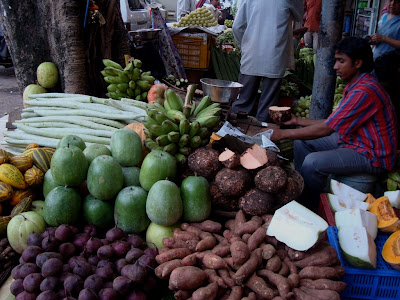I was reminded of how birthdays are celebrated in my Tamil Brahmin community. There are three birthdays that are traditionally celebrated with pomp and splendour - the first birthday, the sixtieth birthday, and the eightieth birthday.
I still remember how joyously we celebrated our daughter Deepa's andu-niravu (first year-completion) with a visit to the temple, an ayush-homam (a prayer ritual for long life) and a grand feast for friends and relatives. A professional photographer was hired, the child was garlanded, and we all posed for photos.

My daughter Deepa's first birthday - outside our old Sion building
I remember my father's sixtieth birthday equally well. His sashti-abda-poorti (sixthieth year completion) was done the traditional way, by conducting a second marriage of him and my mother. My mother wore the traditional nine-yards saree, and amidst the chanting of mantras by the priests, my father tied the yellow thiru-mangalyam (wedding thread) around my mother's neck exactly as he had done on their wedding day.
My father's sixtieth birthday was celebrated along with another important event - my grandfather's eightieth birthday. For the eightieth birthday, children conduct a sadabhishekam (hundredth-year completion) ceremony. After the religious rites are over, everyone queues up with offerings of fruits and gifts to get the blessings of the Grand Old Man.
 My father's sixtieth birthday at Matunga. He is standing next to my mother. My grandfather is seated in front.
My father's sixtieth birthday at Matunga. He is standing next to my mother. My grandfather is seated in front.Outside the sphere of religion, the birthdays that I really enjoy celebrating are those of my ex-colleagues. We are a gang of teachers (many of us 70 and above) who celebrate each others birthdays by organising get-togethers.
It is a day when we set aside our usual responsibilities and worries and live in a different world. We bring gifts and delicacies for the 'Birthday Baby'. We talk, laugh and eat, remniscing and reliving old incidents. We tell each other funny anecdotes, and enjoy the birthday to the fullest, singing 'Happy Birthday to You' as loudly as we can!

 They were assembling several more elephants in the compound nearby (at least 7-8 more). I think they're going to place them all along the road. If you go over the Lalbaug flyover, you'll get a great view of all the elephants being lined up. So hurry! Find some excuse to drive on that route!
They were assembling several more elephants in the compound nearby (at least 7-8 more). I think they're going to place them all along the road. If you go over the Lalbaug flyover, you'll get a great view of all the elephants being lined up. So hurry! Find some excuse to drive on that route!





 My connection with the ash gourd started in the forties, when I was a kid studying at SIES School. For lunch, my mother used to make delicious molagootal - a bland preparation of ash gourd, yam, drumstick, beans, and carrots. The vegetables were boiled with salt, and to this was added tuar dal and coconut paste. We ate it hot with rice and ghee; and sometimes spiced it up with vadu-manga (tender mango) or lemon pickle.
My connection with the ash gourd started in the forties, when I was a kid studying at SIES School. For lunch, my mother used to make delicious molagootal - a bland preparation of ash gourd, yam, drumstick, beans, and carrots. The vegetables were boiled with salt, and to this was added tuar dal and coconut paste. We ate it hot with rice and ghee; and sometimes spiced it up with vadu-manga (tender mango) or lemon pickle. 


